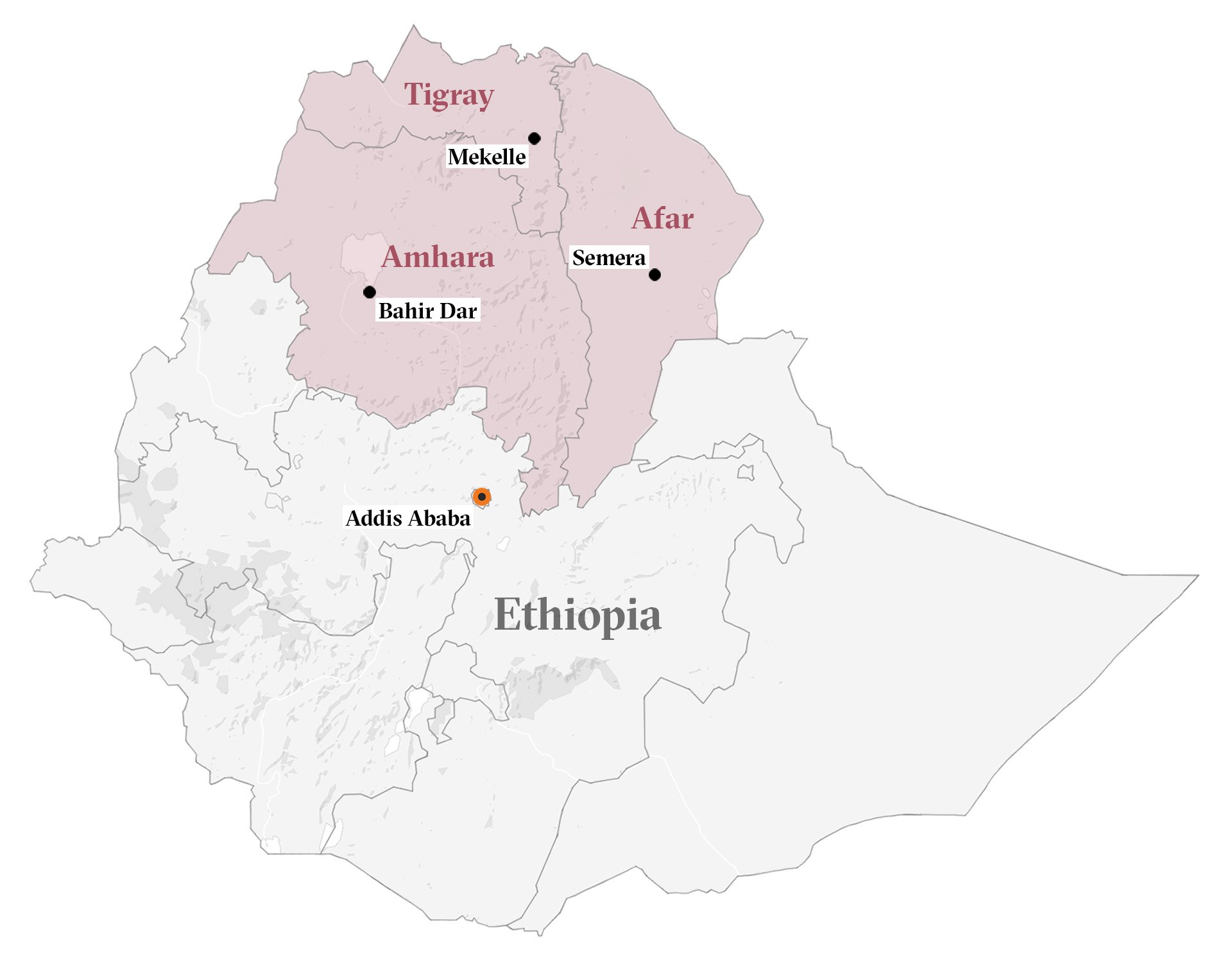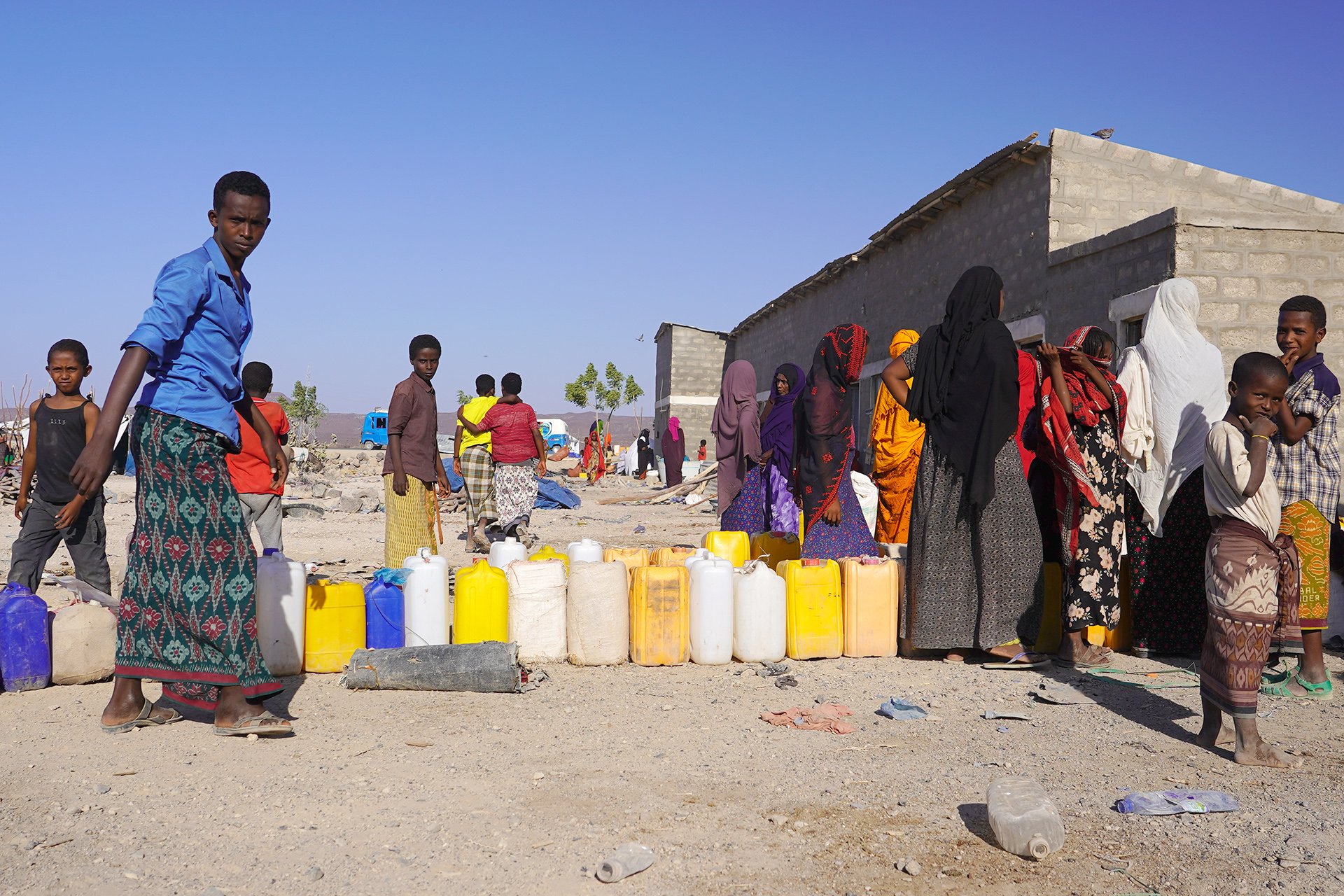Security threats are preventing aid groups from bringing relief supplies into Ethiopia’s northern Tigray region, even as the government has declared a unilateral truce following 17 months of conflict with forces aligned to the Tigray People’s Liberation Front (TPLF).
In a statement on 24 March, federal authorities promised to facilitate aid access into Tigray, having imposed a months-long blockade that has left a population of six million people bereft of health supplies and facing extreme food shortages.
Yet passage for aid convoys is currently constrained by insecurity along the only overland corridor open to relief groups. That route runs through the neighbouring Afar region, where local militias have been supporting the federal government's cause.
Five facts about the humanitarian situation in Tigray
- The scale of food distribution has reached the lowest point since March 2021.
- Diets are extremely limited, and people are cutting back on the number of meals they consume per day.
- People are selling off livestock and reducing their expenditures on health and education to survive.
- The World Health Organization says there is nowhere on Earth where the health of millions of people is more under threat than in Tigray.
- USAID officials have called the blockade in Tigray “perhaps the most egregious humanitarian obstruction in the world”.
Tigrayan forces – which said they would accept the truce should aid be ramped up – launched a military offensive in Afar in January. The operation angered Afar regional leaders who have created obstacles for Tigray-bound UN relief convoys.
Yesterday, on 28 March, the TPLF said their forces were observing a “temporary cessation of hostilities”, though a militia fighter in Afar told The New Humanitarian that fighting was ongoing last night around Barhale, a town close to the Tigray border.
A humanitarian worker based in Afar said aid groups are now planning a scoping mission along the road to Tigray to test the current security situation. If the vehicles proceed safely, a bigger mission may then be planned.
Aid agencies are also discussing the option of using government security escorts – an arrangement that may take time to put in place – said the aid worker, who requested anonymity citing the risk of reprisals from authorities.
Other potential access routes into Tigray could be opened in the adjoining Amhara region, though militia groups there have also been engaged in heavy fighting with Tigrayan forces in recent months and tensions remain high.
Humanitarian convoys have not reached Tigray since mid-December, though smaller shipments of aid do arrive via cargo flights. Hundreds of thousands of people are thought to be in famine, while the absence of fuel and banking services has crippled relief operations.
Another aid worker in the country – also speaking on condition of anonymity – said cash shortages mean their organisation has not paid staff in Tigray for several months. Some staff have been added to the organisation’s food beneficiary lists as a result.

Humanitarian assistance also needs to be scaled up along the Amhara-Tigray border, where new displacements have been reported in recent weeks. It’s also needed in Afar, where local officials say some 200,000 people are trapped in areas inaccessible to aid groups.
“We are lacking food, and we are very worried for our missing family members,” said Hawa Darsa, a displaced resident of Afar, which The New Humanitarian visited in mid-March. Hawa escaped fighting in the town of Konaba and said she had not received any aid.
Continued clashes and blocked aid
The Tigray conflict began in November 2020 after months of tension between Addis Ababa and the TPLF – the ruling party in Tigray and the dominant force in Ethiopian national politics until Prime Minister Abiy Ahmed took office in 2018.
After the government’s initial military campaign failed, it announced a humanitarian ceasefire in June 2021. But it then put Tigray under a siege that USAID officials have called “perhaps the most egregious humanitarian obstruction in the world”.
A subsequent offensive by the TPLF-aligned Tigray Defence Forces (TDF) sought to break the blockade, though the rebels retreated back to their region late last year under a hail of government drone strikes.
Large-scale fighting between the TDF and federal forces has since subsided, while the current truce – which follows sustained diplomatic pressure and comes amid an economic crisis – could pave the way for further talks and a more permanent ceasefire arrangement.
Yet efforts to end the war and ramp up aid will also depend on local leaders and militias in Afar and Amhara. They are still locked in conflict with the TDF, whose forces mobilised en masse in response to killings and ethnic cleansing in 2020 and 2021.
On 22 March, Amhara president Yilkal Kefale said his region – the country’s second most populous – is “building a very large [military] force” with a view to concluding the conflict. Kefale said the Ethiopian federal army is also strengthening itself.
Amhara and Tigray have been caught in a dispute over territory for several decades, though tensions reignited when Amhara militia annexed western Tigray during the current conflict. Neither side seems willing to relinquish their claims to the area.
Ongoing clashes between Tigrayan forces and Afar militia could also derail the truce, with Afar authorities likely to insist on a TDF withdrawal as a condition to allowing overland aid delivery.
The TPLF claims Afar forces made repeated incursions into their region prior to the January offensive, though Afar residents told The New Humanitarian that the TDF invaded without provocation.
Convoys from the World Food Program have been attacked and looted in recent weeks in Afar, forcing the agency to suspend food distributions. Drivers are now increasingly reluctant to take on jobs, according to a second aid worker based in Afar who also requested anonymity.
The latest incident, on 20 March, saw Afar assailants beat drivers and loot food intended for communities in the region. The motive of the attack is unclear, though those involved may have thought the aid was intended for distribution in Tigray.

“If the TDF remains in Afar, maybe that makes it more likely that there will be continued bureaucratic obstruction of aid delivery by regional authorities as well as attacks on convoys in Afar,” said William Davison, an Ethiopia analyst at the International Crisis Group (ICG). “There is plenty of genuine Afar anger at the TDF invasion and occupation of parts of their region,” he added.
That anger was palpable when The New Humanitarian visited Afar earlier this month. Life was suspended in frontline villages and towns, while hospitals were unable to cope with a rising number of casualties – many suffering from burn wounds and blast injuries.
Afar militia fighters, meanwhile, said they were preparing for a protracted conflict. “We [are] fighting for our land,” said Mohammed Aliyu, a former soldier who has been fighting the TDF since January and now wants to join Afar’s police force.
Cancelled cancer treatment and ‘severe’ coping mechanisms
The current tensions along the Afar-Tigray border mean the only way aid can reach Tigray is on humanitarian cargo flights, which resumed service on 24 January with authorisation from the federal government.
Over 220 metric tonnes of medical supplies have now been airlifted, but that represents just four per cent of the total medication required to meet the health needs of Tigray’s population, according to the UN’s emergency aid coordination body (OCHA).
The cancer department at the main referral hospital for Tigray’s capital, Mekelle, has recently had to send patients home because it lacks medication, said Fatima Sator, a spokesperson for the International Committee of the Red Cross. Sator said she was given the information by doctors and didn’t personally see the patients being sent home.
The amount of food transported by air also constitutes “crumbs”, said one of the two aid workers in Afar. The UN says 100 trucks a day are needed to cover humanitarian needs in Tigray.
Lacking provisions and fuel, aid groups have had to reduce their operations or halt them entirely.
Households in the region are currently relying on grains from the last harvest season, and on what the World Food Programme (WFP) calls “severe consumption-based coping strategies” – reducing daily meals and limiting portion sizes.
Large numbers of people have also resorted to begging and selling off their livestock, while over 30 percent of households in Tigray are relying on gifts or loans as their primary source of income, according to WFP.
Lacking provisions and fuel – and with electricity, telecommunications and banking services largely cut off – aid groups have had to reduce their operations or halt them entirely, according to OCHA.
Humanitarian workers in Mekelle told The New Humanitarian that car transportation is now limited to the bare minimum and that employees regularly walk to work on foot to fulfil their duties.
Davison, of the ICG, said real progress requires all parties to the conflict to do their part. "It seems possible that to get trucks moving there needs to be agreement on the sequencing of TDF withdrawal from Afar and Amhara with scaled-up delivery of aid to Tigray,” he said.
"If this doesn’t happen," Davison added, "the truce could get derailed at quite an early point”.
Edited by Philip Kleinfeld.








